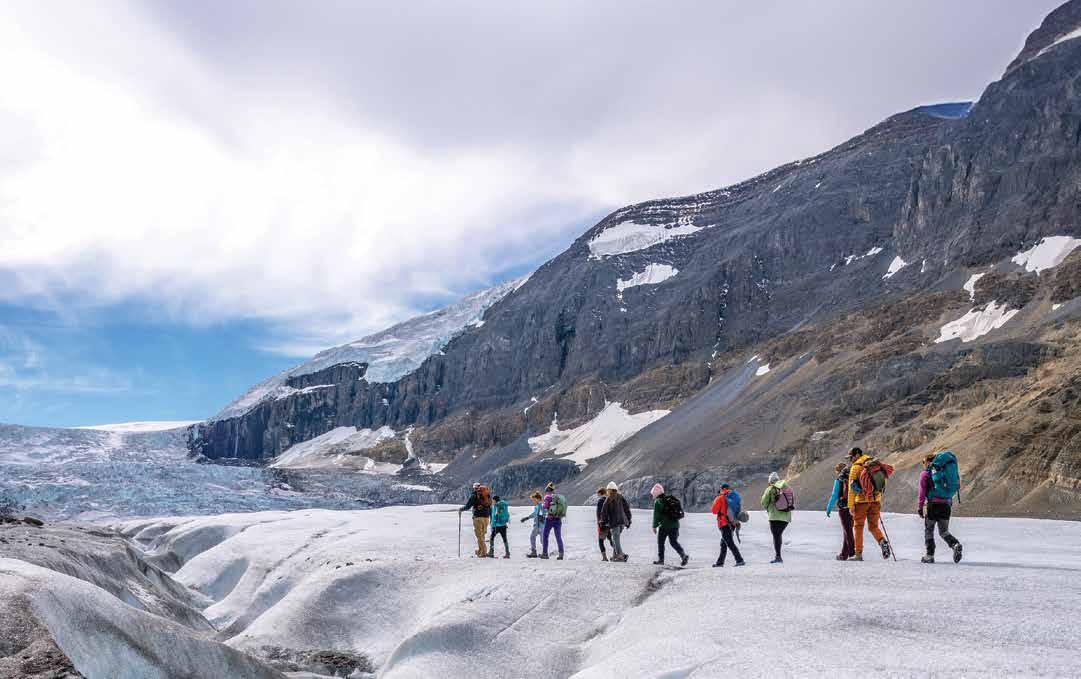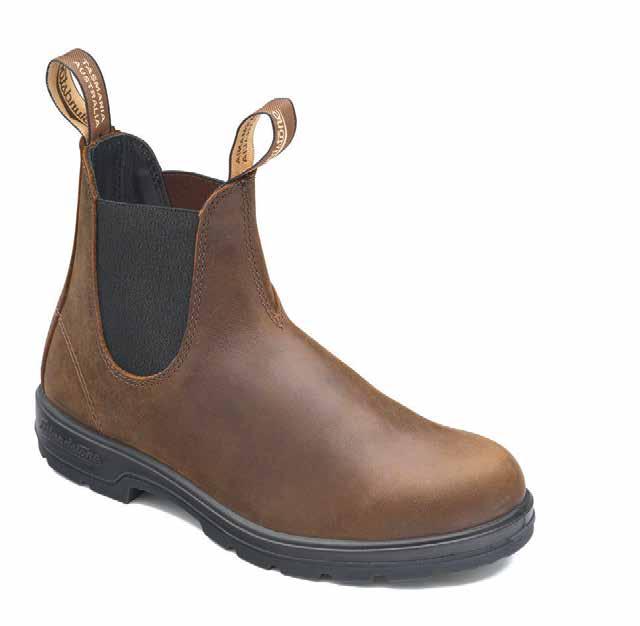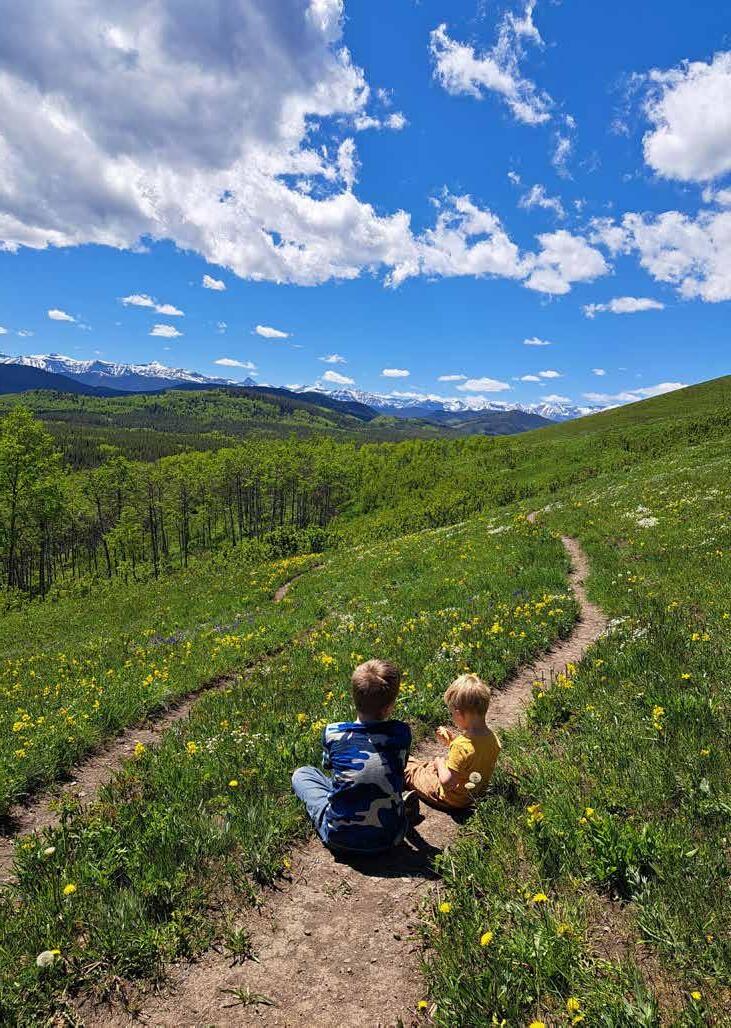
11 minute read
Dodging Cow Pies
Where rangeland and mountain recreation overlap
words
:: Sylvia Dekker
The contradiction wasn’t lost on me. Moments ago, I had tapped my brakes and paused to admire the fluid team of horse, rider and dogs pushing a cluster of bawling bovine off the road and up a grassy slope.
Now on the trail, dodging thick, wet cow pies, I grumbled about the very tradition the cowboy was keeping alive as I squelched up the path, pitted with cloven footprints.
I was beyond the “Welcome to Kananaskis Country” sign, in a sprawling 4,000-square-kilometre puzzle of parks, ecological reserves and wildland areas bejeweled with sundry ecosystems, verdant valleys, shimmering lakes, crumbly peaks and bubbling creeks. More than four million folks flock to this area every year for the endless recreational opportunities and stunning natural beauty.
Back on the highway, other signs jut out along the side of the roads snaking into this worldclass chunk of eastern Rockies: “Kananaskis conservation pass required. Keep your pets on leash. Cattle at large next 22 kms.”
The latter sentence surprises newcomers and annoys regulars. “Why are there cows here anyway?” I overheard a fellow hiker mutter at a muck-splattered trailhead. My toddler is thrilled when moos reverberate down the trail, but for many hikers, hints of farm devalue the wild surroundings.
Kananaskis is not simply a playground for fresh-air lovers, though. In 1978, “K-Country” was born as a multi-use area and notable source of income for both government and private businesses. Timber leases, oil and gas development, recreation, tourism and grazing were expected to share one chunky, complicated zone.
For the most part, recreation and grazing parties coexist well. Hikers rattle over cattle guards, brake for panicking calves and leave gates as they were found.
But there are undercurrents of conflict and concern. Standing on the edges of trampled brooks and sounding off on online forums, recreationists question if cows truly fit in amongst the mountains. Fences, manure and moos are at odds with the vision of a pristine natural area—beef in the backcountry, say some respondents on an online survey, should be phased out. Many recreationists believe the path to ensuring a diverse, healthy environment for plants and animals cannot include grazing, and are not convinced there is benefit seen beyond the rancher’s beefy paycheck.
• • •
Rangelands in Kananaskis are managed under agricultural dispositions, aka grazing permits, or licenses issued and renewed annually by the government and managed through the Kananaskis Country Public Land Use Zone. The disposition holder pays a fee to use the land and, according to the province’s Rangeland Grazing Framework, they collaborate with the government “to ensure that agricultural land use sustains environmental, economic and social benefits for the people of Alberta.”
The economic benefits are clear. Crown rangelands like those grazed in Kananaskis support about 14 per cent of Alberta’s beef herd, an industry that contributes more than $4 billion to the province’s GDP and employs tens of thousands of Albertans.
Grazing dispositions are part of a system developed to avoid the disastrous open-range policy of the United States, which resulted in range wars and environmental degradation. As the land owner, the government is responsible for overarching decisions. The disposition holder is responsible for day-to-day management and invests in their dispositions. “They ensure that they are following legislation and delivering under the stewardship model,” says Lindsye Murfin, manager of the Alberta Grazing Leaseholders Association.
“It is important to not put the financial profit of a few above the well-being of nature, which provides humans many tangible and intangible benefits that may not be measured monetarily but are still incredibly valuable,” says hiker and camper Lucy Poley.
That’s where stewardship comes in. A term that crops up a lot in government and industry documents on the subject, stewardship is the reciprocal relationship leaseholders have with the land.
Lorne Fitch, a retired provincial fish and wildlife scientist, says, “Those that care—the good stewards—are boots on the ground,” something he believes we desperately need in an area “that is a part of Alberta’s DNA.”
Rancher-cowboy Wolter van der Kamp—whose cattle I’ve often encountered in one of my go-to areas in southern Kananaskis—keeps environmental sustainability at the heart of his every day. “Economic benefits aside,” he says, “the use of these lands by animal agriculture offers a vast amount of ecological services which are very hard to put a price on.”
This is all dependent, however, on management. According to the Rangeland Grazing Framework, if managed well, healthy rangelands can provide an array of services, including clean air and water, flood mitigation, biodiversity, wildlife habitat, renewable resources, carbon sequestration, nutrient cycling and the aesthetics of natural landscapes.
Many recreationists question how grazing cattle could possibly contribute to things like aesthetics or clean water. Their worries are well-founded: According to a review on the ecological costs of grazing in the west, studies show the negative effects cattle can have on the ecosystem when grazing is done wrong, from disrupting ecosystem function to altering species composition.
Often, it’s the visually distressing effects that raise criticisms, but most recreationists are simply not on site enough to accurately judge management and impacts. “Some measures may not look great in year one or two but are done for the betterment of the whole system,” explains van der Kamp, adding, “This can be difficult to see unless you’re involved in the long-term planning process.”
For those recreationists—like myself and Poley—with favourite trails and places visited year-round and year after year, the apparent mismanagement of consistently trampled places is troubling and contributes to tensions between livestock and those visiting the areas they graze.
When it comes down to it, it’s not only about aesthetics or having to dodge cow pies.
“Crown and private rangelands of Alberta provide most of the remaining prime habitat for birds, mammals, fish, reptiles, amphibians and insects” says Alberta’s Stewardship for Rangeland Sustainability publication. Yet, drive up one of the multiple roads into Kananaskis, and one is more likely to see cows than the native elk, sheep, deer, bear and moose that call the area home.
In the past, vast herds of bison and elk flowed across the prairiefoothill-mountain interfaces. Grazing was intense and impact severe. Predator pressure and natural migration patterns granted the land periods of rest and recovery.
“The natural system was built by disturbance,” says Fitch, including flooding, grazing and fire, factors which also once kept woody species encroachment under control.
Without licking tongues and flames, van der Kamp says, “Rosehips lead to aspen lead to spruce takeover, and a dense spruce forest is just a green desert.” While each of these species have their place, they can quickly advance on grasslands, one of the most productive, climate-stabilizing and endangered ecosystems on earth.
Countering methane-fueled climate claims, controlling bush and tree density isn’t the only way grazing bovine can help the planet. A study on the effects of large mammalian grazers on soil carbon pool stability says grazing can increase soil carbon sequestration and soil carbon stability, a nature-based climate solution.
While Fitch explains native rangelands do have a maximum saturation point, every bit counts. “For every gram of carbon in the soil,” Murfin says, “that soil can store four grams of water.”
“Eighty to 90 per cent of our water originates in this landscape,” Fitch says. Whether the rain and snow melt can seep into the land versus flowing away depends more on soil compaction—something recreational traffic and logging contribute to—and the amount of ground-covering leaf litter left behind, which grazing can help or hinder.
The overarching consensus on the effects of cattle presence (munching on habitats and their inhabitants): It relies highly on context. The caveat it depends—on species, management, ecosystem and beyond—threads through the research and discussions on the subject.
While cattle are not ecologically synonymous with bison, they currently fill the void left by overhunting at the end of the 19th century, both van der Kamp and Murfin say. Distribution and grazing habits vary between the two species, but cattle now provide part of the disturbance these lands were built with.
Like bison, the impact of cattle on ecosystems and ecological processes come from the ground up: Grazers remove plant biomass, trample, add nutrients, disperse propagules, alter soil compaction and texture, and can modify microclimate. Whether there is a net positive or negative effect depends on grazing frequency and, pivotally, grazing intensity.
These days, grazing intensity—or stocking rate—is controlled by animal unit months (AUMs) and set by the government. An AUM allotment for a particular area is calculated by assessing the forage available against the amount of forage required by one mature cow and her suckling calf—one animal unit—for one month. Bulls may count for two animal units and yearlings less than one, depending on weight. “This allows a different allotment of animals for every spot based on size, shape, terrain and vegetation,” van der Kamp explains.
On grasslands, research shows appropriate stocking rates can support biodiversity by providing resources for species typical of both short and tall vegetation on grazed and ungrazed landscapes. Small mammals adapted to dense cover are impacted negatively by livestock grazing, but species adapted to more open plant communities see a positive impact, says a study on cattle-deer compatibility in North America.
For large mammals, van der Kamp says grazing keeps the plant in a vegetative state longer. This means instead of setting seed and becoming less digestible and nutritious by July, a green plant may freeze up in September. The resulting forage, he explains, has a higher energy and protein content and is more palatable.









“Animals that might have similar diets to cattle, such as ungulates,” says Murfin, “are often found on grazing leases.”
The problem is studies can only speculate through the lens of current perceptions. “What we’re seeing and interpreting as native isn’t,” says Fitch. Though there is an understanding that many rangeland species may benefit from some amounts of grazing, research on ranching conducted in Kananaskis says so far in Canada, the effects of grazing on biodiversity have not been sufficiently examined to garner such sweeping statements.
What we do know, according to research on restoring grazing-induced heterogeneity in Canadian grasslands, is habitat heterogeneity supports biodiversity. When done well, grazing can provide what the Stewardship for Rangeland Sustainability publication calls a “mosaic of disturbance.”
Fitch says it’s when disturbance is perceived as excessive by passersby that folks lash out against grazing.
Cattle naturally respond to variation in topography, forage and water resources, resulting in selective grazing habits. This means favoured forages and habitats like riparian areas can become overused.
Riparian zones—the green ribbons stretching along streams and lakes—are among the most productive habitats in North America. In fact, they support more than 80 per cent of Alberta’s wildlife. What makes them good places for wildlife also means they are attractive to both livestock and recreationists. Poley worries, “These sensitive areas can pretty quickly become destroyed.”
“Properly timed access [to riparian zones] with periods of rest have proven to be beneficial,” says Murfin. “Disturbance often stimulates regeneration.”
When grazing happens too soon, too long, too much and too often, though, these essential belts of life suffer. Streams overused by cattle are wider, shallower and warmer, and have reduced cover and more fine sediment. That’s bad news for baby fish. “Every one of our native trout species is imperiled,” says Fitch. He believes this is a clear report card on our management of the Eastern Slopes overall, though livestock are only one piece of the impact puzzle.
Luckily—as a review on the ecological costs of grazing states— riparian zones are resilient. These areas can repair, revive and thrive if given respite during the growing season and if sensitive areas are avoided during vulnerable periods, Fitch explains.
Van der Kamp knows disturbance during the time of young things, whether plant or animal, can create the biggest impact. The earliest ranchers can move cattle back onto their dispositions, he says, is June 15, meaning bovine are absent during the time birds are nesting and bears are emerging with their cubs.
Distributing cattle so favoured areas don’t become overused is also vital—and a challenge to get right. Disposition holders can manipulate livestock movement and deter predators with horseback range riders and by distributing salt blocks, building trails and developing watering sites such as gravity-filled tanks.
However, van der Kamp tells me water development is not common in Kananaskis dispositions due to logistics. “It’s a very large landscape,” he says. “I’d sure love to see off-site watering in forestry [dispositions], but you’d have to helicopter [supplies] in, and it’d come at an incredible cost.”
Instead, van der Kamp fences off many of his riparian zones in the spring and again in the fall. Not all disposition holders do, though, and seeing a creek with its once green banks grazed down and stinking of farm is upsetting. The way cows can thrash watering sites is not lost on him, but van der Kamp compares the cattle slurping from a creek here or a pond there with our beloved trail network.
“Trails are considered sacrificial ground,” he says. They exist for the greater good, so hiker impact—which Fitch says can be devastating on wildlife populations—is concentrated in a small area. Similarly, sometimes one natural watering site becomes a sacrificial chunk livestock can use so other places can be rested or avoided.
The reality is both the two- and four-legged herds trailing through Kananaskis have rights to Crown land. “Both have more in common than they realize,” says van der Kamp. “We are passionate about the beauty and the ecological benefits we receive from this landscape and feel as though we need to protect it for the future.”








“Let’s get outside of our own perceptions for a while to see the real issue: cumulative impacts of everything we do in the landscape,” says Fitch. It’s the only way to move forward. Unfortunately, van der Kamp and Fitch know that in both camps there are some who care and others who don’t. Proof: trails littered with colourful bags of dog poop.
Unlike those trotting the trails with their four-legged sidekicks, disposition holders are not anonymous. “The department of Forestry and Parks has a fleet of rangeland agrologists whose main job is to ensure that grazing disposition holders are meeting their legislated responsibilities in terms of proper stewardship and range health,” says Murfin.
During field audits and disposition visits, range health—the ability of the rangeland to perform key ecosystem functions—is assessed and measured via a list of set factors. This, along with a stewardship assessment, advises permit renewals or tenure recommendations.
Because it depends, there is no Kananaskis grazing recipe for disposition holders to follow. Instead, there is a pantry of agrologist input, guidebooks and ever-growing and shifting research.
The way forward is a combination of what Fitch says are the three indivisible ingredients of stewardship: awareness, ethics, action. Cows and Fish—a group focused on healthy riparian areas— has spent decades educating people and adapting grazing practices to reflect new insights.

“If we continue to argue over… which one is more important— fish or cows, cows or water quality, water quality or agriculture—we may be missing the point,” says the society’s booklet Riparian Areas and Grazing Management.
Point being cows and wildlife and recreation and aesthetics all have value. “We need to measure these things together as opposed to pitting one land use against another,” says Fitch.
“Getting rid of cattle is not going to fix the issues in our forest reserves,” says Fitch, despite many recreationists believing otherwise. “Look beyond the cow pie.”
Given holistic management and working together, van der Kamp believes, “We can keep our eastern slopes pristine for generations to come.”
For outdoor enthusiasts, the line between annoyance at navigating sloppy trails and appreciating what Poley calls the “stirring” vision of cowboys keeping tradition alive may always be blurry. At the very least, each slippery cow-pie discovery entertains and motivates my little hikers up the trail.







